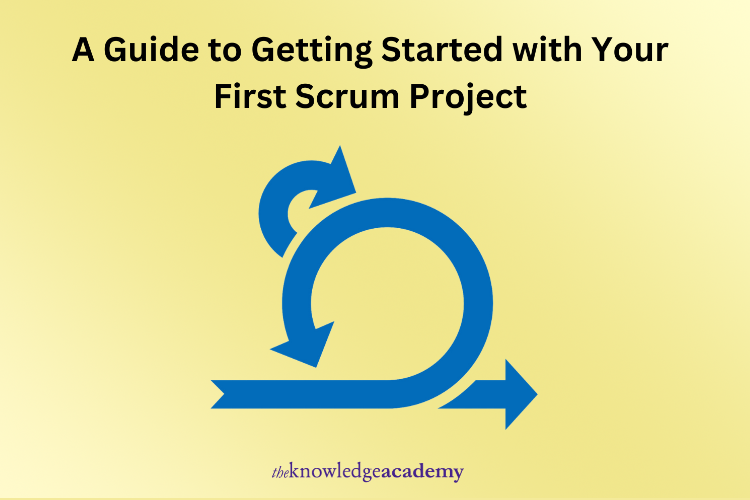Are you excited to start your first Scrum job but also a little stressed? Are you wondering what is scrum and how to start your first Scrum Project? You’re not alone so don’t worry. A lot of people who want to be project managers feel the same way when they first start to learn about Scrum.
To be successful, you need to understand the basic ideas behind Scrum and carefully plan each step of your project. Scrum master courses can give you the information and skills you need to make this journey go smoothly. In this blog we’ll delve into the primary steps that need to be taken to get your first Scrum Project off the ground.

Preparing for Your First Scrum Project
Here are the steps to follow while preparing for your first scrum project:
Step 1: Form Your Scrum Team
Put together a committed group of people including a Scrum Master, Development Team members, and Product Owner. Ensure everyone knows their part and what must be done.
Step 2: Define Your Product Vision
The project’s objectives should be spelt out in a clear and compelling product vision created by the product owner. All through the project, this vision will direct the team and stakeholders.
Step 3: Create the Product Backlog
List every task, function, and user story you will need to develop your product. Sort these according to the degree to which the final users need and value them. Over time, as the project goes on, this original product backlog will change.
Step 4: Set Up Your Scrum Board
Throughout a sprint, a Scrum board facilitates task progress visualisation. Usually, it includes columns for the done, in progress, sprint, and product backlogs. Use digital platforms like Jira, Trello, or Asana or actual boards.
Step 5: Define Your Definition of Done
The Definition of Done (DoD) denotes a consensus among stakeholders regarding the criteria that distinguishes completed work. This should encompass standards such as code review, successful integration, updated documentation, and test pass rates. A well-defined DoD guarantees uniformity in quality and cohesion throughout the team.
Step 6: Set Up Communication Channels
Success with Scrum depends critically on effective communication. For fast, informal communication, set up Slack or Microsoft Teams; for documentation and teamwork, set up Confluence or Google Drive. Daily standups and other regularly planned sessions encourage coordination and rapid resolution of problems.
Executing Your First Scrum Project
After you have fully planned out your Scrum project, it’s time to start working on it. Here is where the planning comes to life and the team starts delivering small pieces of the product. Here is a detailed guide on how to do your first Scrum job right.
Step 1: Sprint Planning
The team chooses what goes into the sprint backlog from the product backlog during the sprint planning meeting. The group then discusses the projects and how much work is needed for each assignment. Make sure the things you choose are doable in the sprint time and match the sprint objective.
Step 2: Daily Scrum Meetings
Every day, hold scrum meetings to keep the team on the same page and up to date. These talks should last no more than 15 minutes and be centred around these three issues:
- What did you do yesterday?
- What will you do today?
- Are there any impediments in your way?
Step 3: Work on the Sprint Backlog
Working in close collaboration and always asking the Product Owner for input, the development team completes the tasks on the sprint backlog. The team should try to finish every assignment and post it to the Scrum board’s “done” column.
Step 4: Sprint Review
To show stakeholders the finished increment, call a sprint review meeting at the conclusion of the sprint. Gathering input and, if necessary, modifying the product backlog are prospects presented here.
Step 5: Sprint Retrospective
Set up a meeting to talk about the sprint in assessment. Talk about what worked and what didn’t, as well as how the team could do better in the next run. The team’s growth and success rely on this ongoing process of getting better.
Conclusion
Beginning your first Scrum project may be a fulfilling experience that promotes better teamwork, higher output, and high-quality product delivery. Scrum success will be yours if you know the fundamentals of the methodology, prepare wisely, and follow this blog contents.


